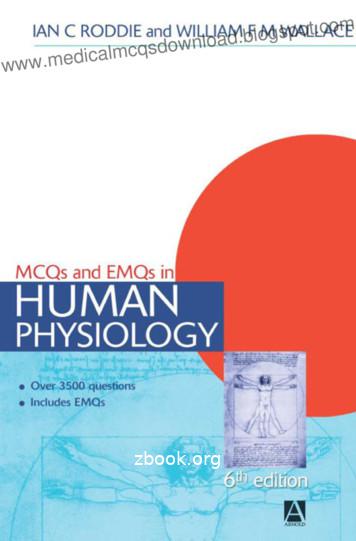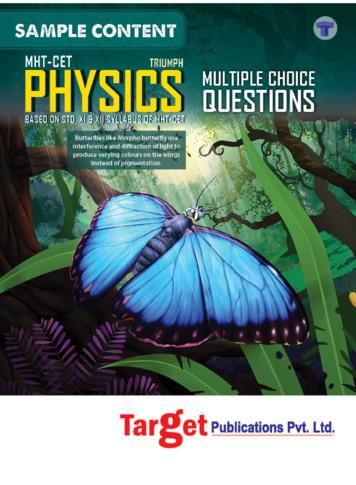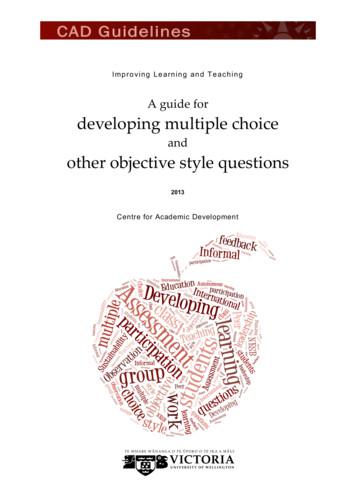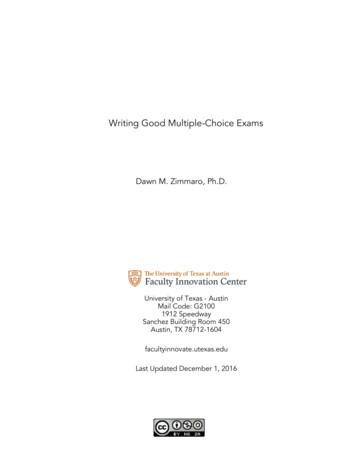Multiple Choice Questions (MCQs)
Lakhmir Singh’sSCIENCEFORCLASS 7s)ing : s (MCQniatCon uestion HighnQoice Based o OTS)hC(HnsipleMult Questio ng Skillss)and r ThinkiswerneadOr(withLakhmir SinghManjit KaurThis Book Belongs to :Name .Roll No.Class and Section .School .Lakhmir Singh’s Science Class 7
S. CHAND SCHOOL BOOKS(An imprint of S. Chand Publishing)A Division of S. Chand And Company Pvt. Ltd.(An ISO 9001 : 2008 Company)7361, Ram Nagar, Qutab Road, New Delhi-110055Phone: 23672080-81-82, 9899107446, 9911310888; Fax: 91-11-23677446www.schandpublishing.com; e-mail : helpdesk@schandpublishing.comBranches :Ahmedabad:Ph: 27541965, 27542369, ahmedabad@schandpublishing.comBengaluru:Ph: 22268048, 22354008, bangalore@schandpublishing.comBhopal:Ph: 4274723, 4209587, bhopal@schandpublishing.comChandigarh:Ph: 2725443, 2725446, chandigarh@schandpublishing.comChennai:Ph: 28410027, 28410058, chennai@schandpublishing.comCoimbatore:Ph: 2323620, 4217136, coimbatore@schandpublishing.com (Marketing Office)Cuttack:Ph: 2332580, 2332581, cuttack@schandpublishing.comDehradun:Ph: 2711101, 2710861, dehradun@schandpublishing.comGuwahati:Ph: 2738811, 2735640, guwahati@schandpublishing.comHyderabad:Ph: 27550194, 27550195, hyderabad@schandpublishing.comJaipur:Ph: 2219175, 2219176, jaipur@schandpublishing.comJalandhar:Ph: 2401630, 5000630, jalandhar@schandpublishing.comKochi:Ph: 2378740, 2378207-08, cochin@schandpublishing.comKolkata:Ph: 22367459, 22373914, kolkata@schandpublishing.comLucknow:Ph: 4026791, 4065646, lucknow@schandpublishing.comMumbai:Ph: 22690881, 22610885, mumbai@schandpublishing.comNagpur:Ph: 6451311, 2720523, 2777666, nagpur@schandpublishing.comPatna:Ph: 2300489, 2302100, patna@schandpublishing.comPune:Ph: 64017298, pune@schandpublishing.comRaipur:Ph: 2443142, raipur@schandpublishing.com (Marketing Office)Ranchi:Ph: 2361178, ranchi@schandpublishing.comSiliguri:Ph: 2520750, siliguri@schandpublishing.com (Marketing Office)Visakhapatnam:Ph: 2782609, visakhapatnam@schandpublishing.com (Marketing Office) 2016 Lakhmir Singh & Manjit KaurAll rights reserved. No part of this publication may be reproduced or copied in any material form (including photocopying or storing it in any medium in form of graphics,electronic or mechanical means and whether or not transient or incidental to some other use of this publication) without written permission of the publisher. Any breachof this will entail legal action and prosecution without further notice.Jurisdiction : All disputes with respect to this publication shall be subject to the jurisdiction of the Courts, Tribunals and Forums of New Delhi, India only.First Published in 2016First Impression 2016ISBN : 9789352530236PRINTED IN INDIABy Vikas Publishing House Pvt. Ltd., Plot 20/4, Site-IV, Industrial Area Sahibabad, Ghaziabad-201010and Published by S. Chand And Company Pvt. Ltd., 7361, Ram Nagar, New Delhi -110 055.Lakhmir Singh’s Science Class 7
An Open LetterDear Friend,ABOUT THE AUTHORSLAKHMIR SINGH did his M.Sc. from DelhiUniversity in 1969. Since then he has been teachingin Dyal Singh College of Delhi University, Delhi.He started writing books in 1980. Lakhmir Singhbelieves that book writing is just like classroomteaching. Though a book can never replace a teacherbut it should make the student feel the presence ofa teacher. Keeping this in view, he writes books insuch a style that students never get bored readinghis books. Lakhmir Singh has written more than15 books so far on all the science subjects: Physics,Chemistry and Biology. He believes in writingquality books. He does not believe in quantity.MANJIT KAUR did her B.Sc., B.Ed. from DelhiUniversity in 1970. Since then she has been teachingin a reputed school of Directorate of Education,Delhi. Manjit Kaur is such a popular science teacherthat all the students want to join those classes whichshe teaches in the school. She has a vast experience ofteaching science to school children, and she knowsthe problems faced by the children in the studyof science. Manjit Kaur has put all her teachingexperience into the writing of science books. Shehas co-authored more than 15 books alongwith herhusband, Lakhmir Singh.It is the team-work of Lakhmir Singh andManjit Kaur which has given some of the mostpopular books in the history of science educationin India. Lakhmir Singh and Manjit Kaur both writeexclusively for the most reputed, respected andlargest publishing house of India : S. Chand andCompany Pvt. Ltd.We would like to talk to you for a few minutes, justto give you an idea of some of the special featuresof this book. Before we go further, let us tell you thatthis book conforms to the NCERT guidelines prescribedby the Central Board of Secondary Education (CBSE).Just like our earlier books, we have written this bookin such a simple style that even the weak students willbe able to understand science very easily. Believe us,while writing this book, we have considered ourselvesto be the students of the concerned class and tried tomake things as simple as possible.The most important feature of this book is that we haveincluded a large variety of different types of questionsfor assessing the learning abilities of the students. Thisbook contains:(i) Objective type questions,(ii) Subjective type questions,(iii) Multiple Choice Questions (MCQs),(iv) Questions based on High Order Thinking Skills(HOTS), and(v) Activities.Please note that answers have also been given forthe various types of questions, wherever required. Allthese features will make this book even more usefulto the students as well as the teachers. “A picturecan say a thousand words”. Keeping this in mind, alarge number of coloured pictures and sketches ofvarious scientific processes, procedures, appliances,manufacturing plants and everyday situations involvingprinciples of science have been given in this book.This will help the students to understand the variousconcepts of science clearly. It will also tell them howscience is applied in the real situations in homes,transport and industry.We are sure you will agree with us that the facts andformulae of science are just the same in all the books,the difference lies in the method of presenting thesefacts to the students. In this book, the various topicsLakhmir Singh’s Science Class 7
of science have been explained in such a simple waythat while reading this book, a student will feel asif a teacher is sitting by his side and explaining thevarious things to him. We are sure that after readingthis book, the students will develop a special interestin science and they would like to study science inhigher classes as well.Books by Lakhmir Singhand Manjit Kaur1. Lakhmir Singh’s Science for Class 32. Lakhmir Singh’s Science for Class 43. Lakhmir Singh’s Science for Class 54. Lakhmir Singh’s Science for Class 6We think that the real judges of a book are theteachers concerned and the students for whom it ismeant. So, we request our teacher friends as wellas the students to point out our mistakes, if any, andsend their comments and suggestions for the furtherimprovement of this book.5. Lakhmir Singh’s Science for Class 76. Lakhmir Singh’s Science for Class 87. Science for Ninth Class (Part 1) PHYSICS8. Science for Ninth Class (Part 2) CHEMISTRYWishing you a great success,9. Science for Tenth Class (Part 1) PHYSICSYours sincerely,10. Science for Tenth Class (Part 2) CHEMISTRY11. Science for Tenth Class (Part 3) BIOLOGY12. Rapid Revision in Science(A Question-Answer Book for Class X)396, Nilgiri Apartments,Alaknanda, New Delhi-110019E-mail : singhlakhmir@hotmail.com13. Science for Ninth Class (J & K Edition)14. Science for Tenth Class (J & K Edition)15. Science for Ninth Class (Hindi Edition) :PHYSICS and CHEMISTRY16. Science for Tenth Class (Hindi Edition) :PHYSICS, CHEMISTRY AND BIOLOGY17. Saral Vigyan (A Question-Answer Science Bookin Hindi for Class X)DISCLAIMERWhile the authors of this book have made every effort to avoid any mistake or omission and have used their skill, expertise and knowledgeto the best of their capacity to provide accurate and updated information, the authors and the publisher do not give any representationor warranty with respect to the accuracy or completeness of the contents of this publication and are selling this publication on thecondition and understanding that they shall not be made liable in any manner whatsoever. The publisher and the authors expresslydisclaim all and any liability/responsibility to any person, whether a purchaser or reader of this publication or not, in respect of anythingand everything forming part of the contents of this publication. The publisher and authors shall not be responsible for any errors,omissions or damages arising out of the use of the information contained in this publication. Further, the appearance of the personalname, location, place and incidence, if any; in the illustrations used herein is purely coincidental and work of imagination. Thus thesame should in no manner be termed as defamatory to any individual.Lakhmir Singh’s Science Class 7
CONTENTS1. NUTRITION IN PLANTS1–16Modes of Nutrition : Autotrophs and Heterotrophs ; Photosynthesis ;Conditions Necessary for Photosynthesis ; How to Test the Presenceof Starch in Leaves ; Leaves of Various Colours ; Importance ofPhotosynthesis ; Other Modes of Nutrition in Plants : Parasites andSaprophytes ; Insectivorous Plants and Symbiotic Plants ; HowNutrients are Replenished in the Soil ; Cells2. NUTRITION IN ANIMALS17–31Animals Take in Food by Different Methods ; Human DigestiveSystem ; To Study the Effect of Saliva on Starch Present in Food ;Teeth : Milk Teeth and Permanent Teeth ; Tooth Decay ; Tongueand its Functions ; Diarrhoea ; Some Animals Eat Grass as Food :Ruminants ; Digestion in Grass Eating Animals ; Amoeba : Feedingand Digestion3. FIBRE TO FABRIC32–41Animal Fibres : Wool and Silk ; Animals That Yield Wool : Sheep,Goat, Yak, Camel, Llama and Alpaca ; Some Indian Breeds of Sheep;Production of Wool ; Occupational Hazard : Sorter’s Disease ; SilkFrom Silkworms ; Life History of Silk Moth ; Production of Silk ;Different Varieties of Silk ; Natural Silk and Artificial Silk ; Discoveryof Silk4. HEAT42–63Hot and Cold ; Temperature ; Measuring Temperature : LaboratoryThermometer, Clinical Thermometer, Digital Thermometer, andMaximum-and-Minimum Thermometer ; Transfer of Heat ; Conduction :Good and Poor Conductors of Heat ; Why do We Wear WoollenClothes in Winter ; Convection in Water and Air ; Sea-Breeze andLand-Breeze ; Radiation ; Absorbers and Emitters of Heat RadiationsLakhmir Singh’s Science Class 7
5. ACIDS, BASES AND SALTS64–78Indicators for Testing Acids and Bases : Litmus, China Rose,Turmeric and Phenolphthalein ; Acids : Organic Acids and MineralAcids ; Strong Acids and Weak Acids ; Acid Rain and its Effects;Bases : Strong Bases and Weak Bases ; Neutral Substances ;Neutralisation ; Neutralisation in Everyday Life ; Salts : NeutralSalts, Acidic Salts and Basic Salts6. PHYSICAL AND CHEMICAL CHANGES79–93Types of Changes : Physical Changes and Chemical Changes ;Differences Between Physical Changes and Chemical Changes ;Importance of Chemical Changes : A Protective Shield of Ozone ;Rusting of Iron ; Conditions Necessary for Rusting ; Rusting DamagesIron Objects ; How do We Prevent Rusting of Iron ; The Case ofShips ; Iron Pillar at Delhi ; Crystallisation7. WEATHER, CLIMATE AND ADAPTATIONSOF ANIMALS TO CLIMATE94–111Weather ; What Produces Weather ; Weather Reports ; Weather Overa Week ; Climate ; Types of Climate ; Factors Which Affect Climate ;Climate and Adaptations ; The Polar Regions : Adaptations in PolarBear and Penguins ; Migration of Birds ; The Tropical Rainforests :Adaptations in Big Cats, Elephants, Red-Eyed Frog, Toucan, Monkeyand Lion-Tailed Macaque8. WINDS, STORMS AND CYCLONES112–131Moving Air is Wind ; Air Exerts Pressure ; Air Expands on Heating ;Wind is Produced Due to Uneven Heating on the Earth by the Sun ;High Speed Winds are Accompanied by Reduced Air Pressure ;Thunderstorm ; Precautions to be Taken During a Thunderstorm ;Cyclone ; Destruction Caused by a Cyclone ; Tornado ; DestructionCaused by a Tornado9. SOILHow Soil is Formed ; Soil Profile : A-Horizon, B-Horizon and CHorizon ; Composition of Soil ; Types of Soil : Sandy Soil, ClayeySoil and Loamy Soil ; Soils and Crops ; Properties of Soil : SoilContains Air and Water (Moisture), Soil Can Absorb Water, SoilAllows Water to Percolate ; Soil Erosion and its Prevention ; SoilPollution and its Prevention.Lakhmir Singh’s Science Class 7132–148
10. RESPIRATION IN ORGANISMS149–168Respiration : Aerobic Respiration and Anaerobic Respiration ;Breathing and Breathing Rate ; Mechanism of Breathing ; Activityto Demonstrate the Mechanism of Breathing ; Activity to Show thatCarbon Dioxide is Produced During Respiration ; Respiration inHumans ; Sneezing and Yawning ; Breathing and Respiration inOther Animals : Earthworm, Frog, Fish and Insects ; Respirationin Plants11. TRANSPORT IN ANIMALS AND PLANTS169–185Transport in Humans : Circulatory System ; Components of Blood :Plasma, Red Blood Cells, White Blood Cells and Platelets ; Heart ;Blood Vessels : Arteries, Veins and Capillaries ; Heartbeats andPulse ; The Case of Sponges and Hydra ; Excretion in Animals ;Excretory System in Humans ; Kidney Failure and Dialysis ; Transportin Plants : Xylem and Phloem12. REPRODUCTION IN PLANTS186–203Methods of Asexual Reproduction in Plants : Vegetative Propagation,Budding, Fragmentation and Spore Formation ; Sexual Reproductionin Plants Through Flowers ; Male Part of Flower : Stamen ; FemalePart of Flower : Pistil ; Pollen Grains and Ovules ; Pollination andFertilisation ; Formation of Fruits and Seeds ; Dispersal of Fruitsand Seeds ; Germination of Seeds13. MOTION AND TIME204–226Speed ; Units of Speed ; Numerical Problems Based on Speed ;Measuring Speed ; Speeds of Some Animals ; Uniform and NonUniform Speed ; Graphical Representation of Motion : DistanceTime Graphs ; Bar Graph and Pie Chart ; Time ; Measurement ofTime in Ancient Times ; Units of Time ; Simple Pendulum ; PendulumClock ; Quartz Clocks and Watches14. ELECTRIC CURRENT AND ITS EFFECTS227–247Electric Circuits and Circuit Diagrams ; Battery ; Heating Effect ofElectric Current and its Applications ; Electric Heating Appliances :Electric Room Heater and Electric Iron ; Electric Bulb, FluorescentTubes and Compact Fluorescent Lamps (CFLs) ; Electric Fuse ;Short Circuit and Overloading ; MCB ; Magnetic Effect of ElectricCurrent ; Electromagnets ; Uses of Electromagnets ; Electric BellLakhmir Singh’s Science Class 7
15. LIGHT248–277Reflection of Light ; Real Images and Virtual Images ; Characteristicsof Image Formed by a Plane Mirror ; Images Formed by SphericalMirrors : Concave Mirrors and Convex Mirrors ; Uses of ConcaveMirror and Convex Mirror ; Images Formed by Spherical Lenses :Convex Lenses and Concave Lenses ; Uses of Convex Lens andConcave Lens ; Dispersion of Light and Rainbow.16. WATER : A PRECIOUS RESOURCE278–288Forms of Water : Solid, Liquid and Gas ; Usable Water on Earth isLimited ; Scarcity of Water ; Groundwater as an Important Sourceof Water ; Water Table and Aquifer ; Depletion of Water Table ;Mismanagement of Water ; Proper Management of Water : RainwaterHarvesting , Revival of Bawris and Drip Irrigation ; Effects of WaterScarcity on Plants17. FORESTS : OUR LIFELINE289–301Components of a Forest : Plants, Animals, Decomposers, Soil,Water and Air ; Structure of a Forest : Canopy, Understorey, ShrubLayer, Herb Layer and Forest Floor ; Forests are Important forMaintaining Balance of Carbon Dioxide and Oxygen in Atmosphere,Water Cycle, Prevention of Soil Erosion and Floods, and Conservationof Wildlife18. WASTEWATER STORYUsed Water is Wastewater ; Sewage and its Composition ; Sewersand Sewerage System ; Sewage is Harmful ; Waste-Water TreatmentPlant (or Sewage Treatment Plant) ; Some Good HousekeepingPractices ; Sanitation and Disease ; Alternative Arrangementsfor Sewage Disposal : Septic Tanks, Composting Pits, ChemicalToilets, Vermi-Processing Toilets and Aeroplane Toilets ; Sanitationin Public PlacesLakhmir Singh’s Science Class 7302–312
CHAPTER1Nutrition in PlantsAll the living organisms (plants and animals) require food. The organisms need to take food (i) toobtain energy (ii) to obtain materials for growth, and (iii) to obtain materials for the repair ofdamaged parts of the body. The process of taking food by an organism as well as the utilisationof this food by the organism is called nutrition. Plants can make their own food but animals (includinghuman beings) cannot make food themselves. They obtain food from plants or other animals that eatplants. Thus, human beings and animals depend on plants for their food, directly or indirectly. We willnow discuss the various modes of nutrition in organisms.MODES OF NUTRITIONThe methods of obtaining food are called modes of nutrition. On the basis of their modes of nutrition,all the organisms can be divided into two main groups :1. Autotrophs (or Autotrophic), and2. Heterotrophs (or Heterotrophic).We will now describe both these modes of nutrition of organisms in detail, one by one.Autotrophs : Autotrophic Mode of NutritionThose organisms which can make food themselves from simple substances (like carbon dioxide andwater) by the process of photosynthesis, are called autotrophs (and their mode of nutrition is calledautotrophic). All the green plants are autotrophs. This is because green plants can make their own foodfrom simple substances like carbon dioxide and water present in their surroundings by the process ofphotosynthesis. In other words, green plants have autotrophic mode of nutrition. For example, wheatplants are autotrophs (having autotrophic mode of nutrition). Autotrophs contain a green pigment calledchlorophyll which helps them make food by absorbing energy from sunlight. Most of the plants are green1Lakhmir Singh’s Science Class 7
2and hence synthesise (make) their own food (see Figure 1).This means that most of the plants have autotrophic mode ofnutrition. The green plants produce food not only forthemselves, they also make food for non-green plants aswell as for animals (including human beings).Our body (and that of other animals) cannot make foodfrom carbon dioxide and water present around us by theprocess of photosynthesis (like the plants do) because ourbody does not have the green pigment called chlorophyll(which the plants have).The green pigment chlorophyll isnecessary to absorb energy from sunlight required formaking food by photosynthesis.Figure 1. Green plants can make food themselvesby photosynthesis, so they are autotrophs. Greenplants have autotrophic mode of nutrition.Heterotrophs : Heterotrophic Mode of NutritionThose organisms which cannot make food themselves by the process of photosynthesis and takefood from green plants or animals, are called heterotrophs (and their mode of nutrition is calledheterotrophic). All the non-green plants and animals(including human beings) are heterotrophs.The non-greenplants do not have chlorophyll for carrying out the processof food making called photosynthesis. So, they depend onother organisms (plants or animals) for obtaining theirfood. The non-green plants called fungi (such asmushroom, yeast and bread mould) are heterotrophs. Theyhave heterotrophic mode of nutrition. Certain bacteria arePlantsalso heterotrophs. All the animals (including humanbeings) are categorised as heterotrophs because they Figure 2. Animals obtain their food from othercannot make their own food, they depend on plants or organisms (like plants or other animals), so they areother animals for obtaining their food. Thus, all the animals heterotrophs. Animals have heterotrophic mode oflike cat, dog,
6. Lakhmir Singh’s Science for Class 8 7. Science for Ninth Class (Part 1) PHYSICS 8. Science for Ninth Class (Part 2) CHEMISTRY 9. Science for Tenth Class (Part 1) PHYSICS 10. Science for Tenth Class (Part 2) CHEMISTRY 11. Science for Tenth Class (Part 3) BIOLOGY 12. Rapid Revision in Science
MCQs 261-330 115 EMQs 331-340 139 6 Special senses MCQs 341-384 149 EMQs 385-394 163 7 Urinary system MCQs 395-434 171 EMQs 435-444 185 8 Endocrine system MCQs 445-501 193 EMQs 502-512 211 9 Reproductive system MCQs 513-567 219 EMQs 568-576 237 l0. General questions MCQs 577-639 245 EMQs 640-649 265 11 Sport and exercise physiology MCQs 650-686 .
MHT-CET Syllabus. Exhaustive subtopic wise coverage of MCQs. Notes, Shortcuts, Mindbenders, Formulae provided in each chapter. Various competitive exam questions updated till the latest year. Includes MCQs from NEET 2016, 2017 and 2018. Includes MCQs upto MHT-CET 2018. Evaluation test provided at the end of each chapter.
Developing multiple choice and other objective style questions 4 2. Writing multiple choice questions THE FORMAT of a multiple choice question Multiple choice questions are the most commonly used format for presenting objective-style questions. A multiple choice question consists of two parts ñ A stem and several options or alternatives.
learning strategies, but creating MCQs requires both in-depth content knowledge and sophisticated analytical thinking. Therefore, we piloted an MCQ-writing task in which students developed MCQs for their peers to answer. Methods: Students in a fourth-year anatomic pathology course (N 106) were required to write MCQs using the PeerWise platform.
Figure 1: A two-tier multiple-choice question in the format suggested in this paper, used in an exam in 2014. 2Description and design of our two-tier multiple-choice questions 2.1Basic structure of our two-tier multiple-choice questions There are several different ways to formulate two-tier multiple-choice questions. The type of
Multiple Choice Questions (MCQs) 1.Which of the following is a non-renewable source of energy? (a)Wood . Oxides of carbon, nitrogen and sulphur mix with rain water to form acids. This causes acid rain. Exercise. . Water cycle is driven by sun and hence kinetic energy in water is because of sun. Hence, it is said that sun is the ultimate .
Question Bank - Multiple Choice Questions (MCQs) Unit 1: Nature of Management 1) Which one of the following statements is not correct? a) Management is a goal-oriented process. b) Management is
Test Blueprint 10 Preparing to Write Items 11 Description of Multiple-Choice Items 12-15 Multiple-Choice Item Writing Guidelines 16-18 Guidelines to Writing Test Items 19 Sample Multiple-Choice Items Related to Bloom’s Taxonomy 21-23 More Sample Multiple-Choice Items 24-25 Levels of Performance and Sample Prototype Items 26 Good versus Poor Multiple-Choice Items 27-28 Activity: Identifying .























